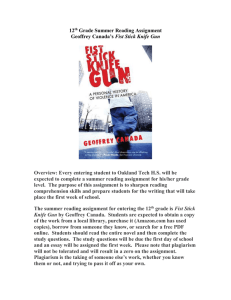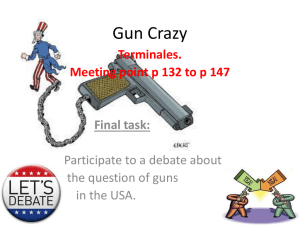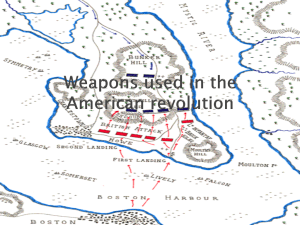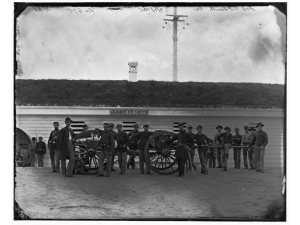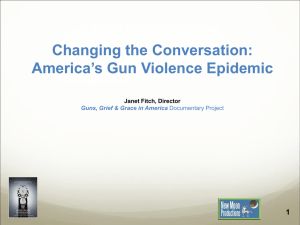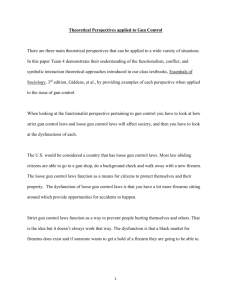Trenton Dean Prof. Heiniger Comp 1103 (Honors) 11/11/14
advertisement
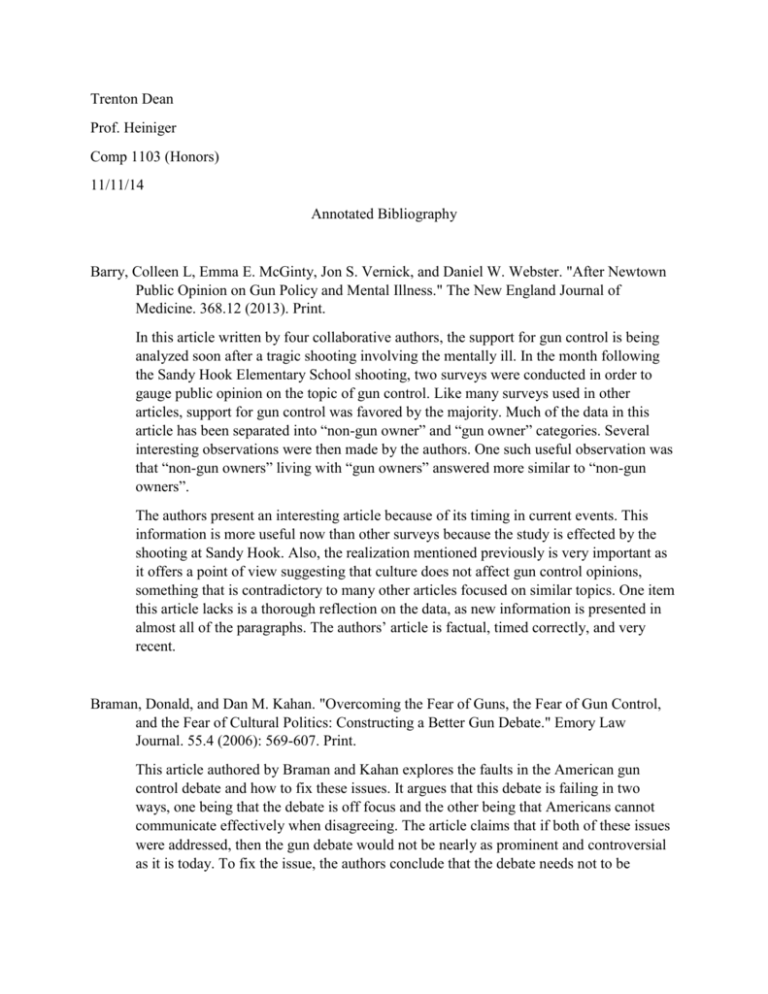
Trenton Dean Prof. Heiniger Comp 1103 (Honors) 11/11/14 Annotated Bibliography Barry, Colleen L, Emma E. McGinty, Jon S. Vernick, and Daniel W. Webster. "After Newtown Public Opinion on Gun Policy and Mental Illness." The New England Journal of Medicine. 368.12 (2013). Print. In this article written by four collaborative authors, the support for gun control is being analyzed soon after a tragic shooting involving the mentally ill. In the month following the Sandy Hook Elementary School shooting, two surveys were conducted in order to gauge public opinion on the topic of gun control. Like many surveys used in other articles, support for gun control was favored by the majority. Much of the data in this article has been separated into “non-gun owner” and “gun owner” categories. Several interesting observations were then made by the authors. One such useful observation was that “non-gun owners” living with “gun owners” answered more similar to “non-gun owners”. The authors present an interesting article because of its timing in current events. This information is more useful now than other surveys because the study is effected by the shooting at Sandy Hook. Also, the realization mentioned previously is very important as it offers a point of view suggesting that culture does not affect gun control opinions, something that is contradictory to many other articles focused on similar topics. One item this article lacks is a thorough reflection on the data, as new information is presented in almost all of the paragraphs. The authors’ article is factual, timed correctly, and very recent. Braman, Donald, and Dan M. Kahan. "Overcoming the Fear of Guns, the Fear of Gun Control, and the Fear of Cultural Politics: Constructing a Better Gun Debate." Emory Law Journal. 55.4 (2006): 569-607. Print. This article authored by Braman and Kahan explores the faults in the American gun control debate and how to fix these issues. It argues that this debate is failing in two ways, one being that the debate is off focus and the other being that Americans cannot communicate effectively when disagreeing. The article claims that if both of these issues were addressed, then the gun debate would not be nearly as prominent and controversial as it is today. To fix the issue, the authors conclude that the debate needs not to be focused on empirical data, rather than cultural views. Unfortunately, as the article later points out, this is no easy task. Unlike several of the other mentioned articles, this paper does not utilize surveys as a primary source. Instead, the article is focused on showing exactly why surveys should not be used as support in the gun control debate. The evidence utilized by this article is cultural data, which creates a source that is not only useful and insightful but also scholarly. The extremely thorough analysis in this article does make this article hard to understand at times, but this is a tradeoff for the quality information received from such a scholarly source. Braman and Kahan’s article is very detailed, informative, and wellresearched. Cooke, CA, and JE Puddifoot. "Gun Culture and Symbolism Among U.k. and U.s. Women." The Journal of Social Psychology. 140.4 (2000): 423-33. Print. This article, written by two authors, explores the differences in gun control opinions between UK and US women. This experiment to find the cultural differences was executed exclusively with female college students from the UK and southern California. The results showed that men were more likely to own guns in the US and UK than women, but the difference was greater in the US. This information was then compared to many other relevant statistics. Like the previous two articles, this article is supported by facts. However, unlike those articles, the focus is more comparative of facts rather that analytical. This creates a very clear argument to support the idea that culture is what creates gun control opinions. This article has also been well-researched, as it uses other researchers’ tests to compare data. The authors of this article created a very well-researched, factual, and simple article. Felson, Richard B, and Paul-Philippe Pare. "Gun Cultures or Honor Cultures? Explaining Regional and Race Differences in Weapon Carrying.(report)." Social Forces. 88.3 (2010). Print. In this article written by two authors, the correlation between different demographics and Honor Cultures is explored. Race, location, and gender are all explored and tested via collected data on the percentage of people who carry a gun for personal protection. One of the general trends is white southern males are more likely to carry a gun than northern white men. This is similarly true for women as well. The article then begins to discuss why this trend is true. Again, this boils down to the cultural differences of the north and south. This article utilizes facts and surveys as its primary source for explanation. Unlike the others, this article more clearly sites the information and uses a variety of information from differing dates. This creates extremely accurate data for the researchers to complete their paper with. Also, the article correlates differing reasons very well, and brings to light how culture effects gun control in many ways. This article written by two authors is very clear, uses quality information and studies, and makes very useful correlations for a research paper. Fremling, Gertrud M, and John R. J. Lott. "The Surprising Finding That "cultural Worldviews" Don't Explain People's Views on Gun Control.(response to Article by Dan M. Kahan and Donald Braman in This Issue, P. 1291)." University of Pennsylvania Law Review. 151.4 (2003). Print. In this response article written by Fremling and Lott, the opposite position is being taken when compared to David Mustard’s response to Kahan and Braman’s article. In Fremling and Lott’s response, the point being made is that empirical data is equally or more influential on gun control opinions. The root of their argument is that the cultural beliefs about gun control, that are supposedly the most “influential”, had to be made based on empirical data at some point in the past. The authors then make several relevant comparisons demonstrating the idea that data always creates a culture’s beliefs. The paper moves on to discuss the evidence used in the original article and concludes by questioning the original article’s authors, Kahan and Braman. This article is very useful for further research. The reasoning for this is primarily because it directly counters the original article and a response by another mentioned author. This allows for the weak points in both arguments to show, leaving space for another opinion on the issue. This article is very informative, however, it seems to lack actual data unlike the original article it is responding to. This does not invalidate the article, but it does show the weaknesses for this viewpoint. This response article written by Fremling and Lott shows a unique perspective, is insightful and useful for comparison. Kahan, Dan M. "The Gun Control Debate: a Culture-Theory Manifesto.(john Randolph Tucker Lecture)." Washington and Lee Law Review. 60.1 (2003): 3-12. Print. Kahan, in his article, discusses one of the main issues why gun control opinions are so extremely divided. To explain this division, Kahan shows, using demographical statistics, that gun control opinions are created by culture, not empirical data. Kahan even quoted a Senator saying a very similar thing about gun control opinions and their origin. Later in the article, the idea of gun control being based on culture’s “risk theory”. Kahan them compares these “risks” with other risks effecting culture, to reinforce the truth that gun control opinion stems from cultural differences. The use of data and comparisons in Kahan’s article makes it very persuasive and informative. This differing approach creates an article that is extremely useful for new research. The information provided in this article is also well supported, much like the previous article, as facts and sources are abundant. Another great feature of this article is the Kahan’s unbiased opinion. He states this very clearly in the second paragraph, and it is noticeable throughout the rest of the paper. Kahan’s article is very persuasive, insightful with a new perspective, and descriptive. Kleck, Gary. "Crime, Culture Conflict, and the Sources of Support for Gun Control: a Multilevel Application of the General Social Surveys." The American Behavioral Scientist. 39.4 (1996): 387. Print. In Gary Kleck’s article, he examines and discusses whether gun control support is increased in citizens because of personal events or cultural beliefs. The author used General Social Surveys (GSS) results to aid his analysis. Along with other information, Kleck was able to collect opinions on gun control from varying cities across America. Upon analyzing his results, the author found that elevated crime rates and prior experience with violence and crime had very little to no effect on gun control opinions. In some cases, Kleck found that violence actually increased citizen’s opposition to gun control. This article is primary based on surveys from varying cities across America. This creates a very factual and concrete argument on the cause for gun control opinions. Unfortunately, an article based almost entirely on national surveys from only a few select cities is not applicable to all of society. Furthermore, this information may also be out of date, since these surveys were taken in the 1990s. The author does however prove his claims well with other articles and facts from the surveys. Kleck’s article is very factual, straightforward and well-researched. Kleck, G, M Gertz, and J Bratton. "Why Do People Support Gun Control?: Alternative Explanations of Support for Handgun Bans." Journal of Criminal Justice. 37.5 (2009): 496-504. Print. In this article written by three authors in collaboration, the reasoning behind support for or against gun control is explored. Through research and many statistics, the authors concluded that opinions on gun control are generally not caused from personal experience, but rather cultural experience. The fact that gun crime statistics have changed drastically over the past years is not reflected in the change of gun control opinions. The authors stated that instead, the slow change in culture has a much more direct relationship with gun control ideals. As used in other articles, facts make up a large percentage of the support in this article. However, this article offers its own unique perspective to explain why culture has a large effect on public opinion on gun control. This article is very well supported and explained in detail. An example of this is the phone survey the authors utilized. This article also recognizes several hypothesis, and explains why or why not they are concise. The authors of this article do a good job creating a very informative article that explains both sides of the divided opinion. Mustard, David B. "Culture Affects Our Beliefs About Firearms, but Data Are Also Important.(response to Article by Dan M. Kahan and Donald Braman in This Issue, P. 1291)." University of Pennsylvania Law Review. 151.4 (2003). Print. In David Mustard’s response to Kahan and Braman, he proves that people’s cultural beliefs play a much larger effect on their gun control beliefs than that of actual data. He concludes this through multiple tests of random citizens, where participants are asked to what degree many gun related crimes are committed. To no surprise, the pre-existing ideas that the participants had on the topic greatly affected the answers given. Even with this conclusion, Mustard went on to conclude that data is still important as it is persuasive for a percentage of the population. Mustard’s conclusion on culture’s effect on gun control is most certainly a viable source. By testing citizens with a few simple questions, Mustard was able to turn his hypothetical conclusion into a legitimate claim. Adding to the article, Mustard also discussed how he has seen culture affect gun control opinions during his speeches he presents. This article provides information that is still applicable ten years later. Mustard’s response article is well-researched, proven with data, and insightful. Schuman, H, and S Presser. "The Gun Control Paradox." Contexts. 12.2 (2013): 68-69. Print. In this article, written by Howard Schuman and Stanley Presser, the correlation between opinion strength and extent of action for the controversial topic of gun control is explored. Like several of the previously mentioned articles, surveys are used to become aware of public opinions. The three conclusions that were drawn in the article from these surveys were the publics’ opinion on gun control, how strong this opinion was, and to what extent have they taken action towards enforcing their opinion. The authors found that a majority of society supported gun restrictions. They also found that these supporters of gun control were more strongly opinionated on this topic than the opponents of gun control. However, the opponents of gun control were found to be taking more action than the supporters. This was labeled the “Gun Control Paradox”. Schuman and Presser did a very good job writing this short article. The article uses quality data collected from surveys and compares this data to nationally recognized surveys. Also, a strong analysis and conclusion of data is presented, making a very reader friendly article great for expanding research. The data is extremely modern, with the surveys being completed in the last few years. Schuman and Presser’s article is very modern, insightful and useful for comparison and expansion of ideas. Research Question: Is the gun control argument able to be settled, or will cultural differences always play too large of a role in public gun control opinion for an agreement to be reached? I have neither given nor received unauthorized aid in completing this work, nor have I presented someone else’s work as my own. Trenton Dean

